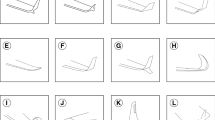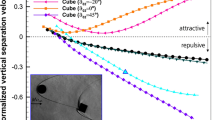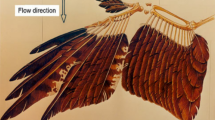Abstract
The capacity of vertical splitter plates placed at the front or the rear of a simplified car geometry to reduce drag, with and without skew angle, is investigated for Reynolds numbers between 1.0 × 106 and 1.6 × 106. The geometry used is a simplified geometry to represent estate-type vehicles, for the rear section, and MPV-type vehicle. Drag reductions of nearly 28% were obtained for a zero skew angle with splitter plates placed at the front of models of MPV or utility vehicles. The results demonstrate the advantage of adapting the position and orientation of the splitter plates in the presence of a lateral wind. All these results confirm the advantage of this type of solution, and suggest that this expertise should be used in the automotive field to reduce consumption and improve dynamic stability of road vehicles.
























Similar content being viewed by others
Abbreviations
- L A :
-
Length of the Ahmed body
- l A :
-
Rear window length
- w A :
-
Width of the Ahmed body
- H A :
-
Total height of the Ahmed body
- h :
-
Height of the geometry front part
- w :
-
Width of the geometry front part
- Re :
-
Reynolds number based on the geometry length
- \( \overline{\overline{{\tau_{\mu } }}} \) :
-
Viscous shear stress tensor
- \( \overline{\overline{{\tau_{t} }}} \) :
-
Turbulent shear stress tensor
- P io :
-
Farfield total pressure
- P :
-
Static pressure
- dσ :
-
Surface element
- \( \vec{n} \) :
-
Normal vector unit
- \( \vec{x} \) :
-
Vector unit in the longitudinal plane
- \( \Upsigma \) :
-
Surface of the outlet boundaries around Ahmed body (\( \Upsigma = \Upsigma_{\text{L}} + S_{\text{e}} + S_{\text{s}} + S_{\text{c}} \))
- \( \Upsigma_{\text{L}} \) :
-
Lateral surface
- \( S_{\text{e}} \) :
-
Inlet section (engine compartment)
- \( S_{\text{s}} \) :
-
Outlet section (engine compartment)
- \( S_{\text{c}} \) :
-
Body surface
- \( \vec{V}_{0} \) :
-
Upstream velocity vector
- \( \vec{V} \) :
-
Local velocity vector
- V x , V y , V z :
-
Velocity components
- \( (\vec{x},\,\vec{y},\,\vec{z}) \) :
-
Vector unit system related to the model
- S :
-
Transversal section immediately downstream of the bluff body
- C p :
-
Static pressure coefficient
- ρ :
-
Density
- α:
-
Angle between the rear window and the upstream flow direction
- β :
-
Skew angle
- λ :
-
Orientation angle of the splitter plate related to the body
- θ :
-
Angle between the splitter plate and the velocity V o
- C d :
-
Aerodynamic drag coefficient
- C dref :
-
Reference aerodynamic drag coefficient
References
Ahmed SR, Ramm R, Faltin G (1984) Some salient features of the time averaged ground vehicle wake. SAE technical Paper Series 840300
Ardonceau P, Amani G (1992) Remarks on the relation between lift induced drag and vortex drag. Eur J Mech B 11(4):455–460
Arnald D, Cousteix J, Michel R (1976) Couche limite se développant avec gradient de pression positif dans un écoulement extérieur turbulent, La Recherche Aérospatiale, n°1976-1
Baudoin JF, Aider JL (2008) Drag and lift reduction of a 3D bluff body using flaps. Exp Fluids 44:491–501. doi:10.1007/s00348-007-0392-1
Cousteix J (1989) Aérodynamique, Turbulence et Couche Limite. Cepadues-Editions, Toulouse, pp 11–14
Gad-el-Hak M (1996) Compliant coatings: a decade of progress. In: Workshop on flow control—fundamentals and practices, Cargèse, Corse, 1996
Gilliéron P, Chometon F (1999) Modelling of stationary three dimensional detached airflows around an Ahmed reference body. In: Proceedings of the third international workshop on vortex, ESAIM, vol 7, pp 173–182
Granville PS (1985) Mixing length formulation for turbulent boundary layers over arbitrarily rough surfaces. J Ship Res 29(4):223–233
International Energy Agency (IEA) (2007) World energy outlook 2007—China and India insights (executive summary). International Energy Agency, ISBN: 978-92-64-02730-5
Kourta A, Vitale E (2008) Analysis and control of cavity flow. Phys Fluids 20:0771041 (10 pp)
Levallois E, Gilliéron P (2005) Contrôle des écoulements en aérodynamique automobile & réduction de traînée par éléments séparateurs - Analyse par PIV, Colloque National de Visualisation et de Traitement d’Images en Mécanique des Fluides, Fluvisu11, Lyon, 6–9 juin
Mair WA (1965) The effect of a rear mounted disc on the drag of a blunt based body of revolution. Aeronaut Q 16:350–360
Onorato M, Costelli A, Garonne A (1984) Drag measurement through wake analysis, SAE, SP-569. In: International congress & exposition, Detroit, MI, 27 February–2 March 1984, pp 85–93
Passenger Cars, University of Sheffield and University of Michigan, Produced by SASI Group (Sheffield) and Mark Newmann (Michigan), Map031, 2006
Roshko A, Koenig K (1978) Interaction effects on the drag of bluff bodies in tandem. In: Sovran G, Morel T, Mason WT (eds) Aerodynamic drag mechanisms of bluff bodies and road vehicles. Plenum, New York, pp 253–286
Rossiter JE (1964) Wind tunnel experiments on the flow over rectangular cavities at subsonic and transonic speeds. Aeronautical Research Council Reports and Memo n° 3438
Spohn A, Gilliéron P (2002) Flow separations generated by a simplified geometry of an automotive vehicle. In: IUTAM symposium on unsteady separated flows, Toulouse, France, 8–12 April 2002
Author information
Authors and Affiliations
Corresponding author
Rights and permissions
About this article
Cite this article
Gilliéron, P., Kourta, A. Aerodynamic drag reduction by vertical splitter plates. Exp Fluids 48, 1–16 (2010). https://doi.org/10.1007/s00348-009-0705-7
Received:
Revised:
Accepted:
Published:
Issue Date:
DOI: https://doi.org/10.1007/s00348-009-0705-7




